Electronics System Design and Manufacturing (ESDM) Industry
July 22, 2023 | Deep Dives
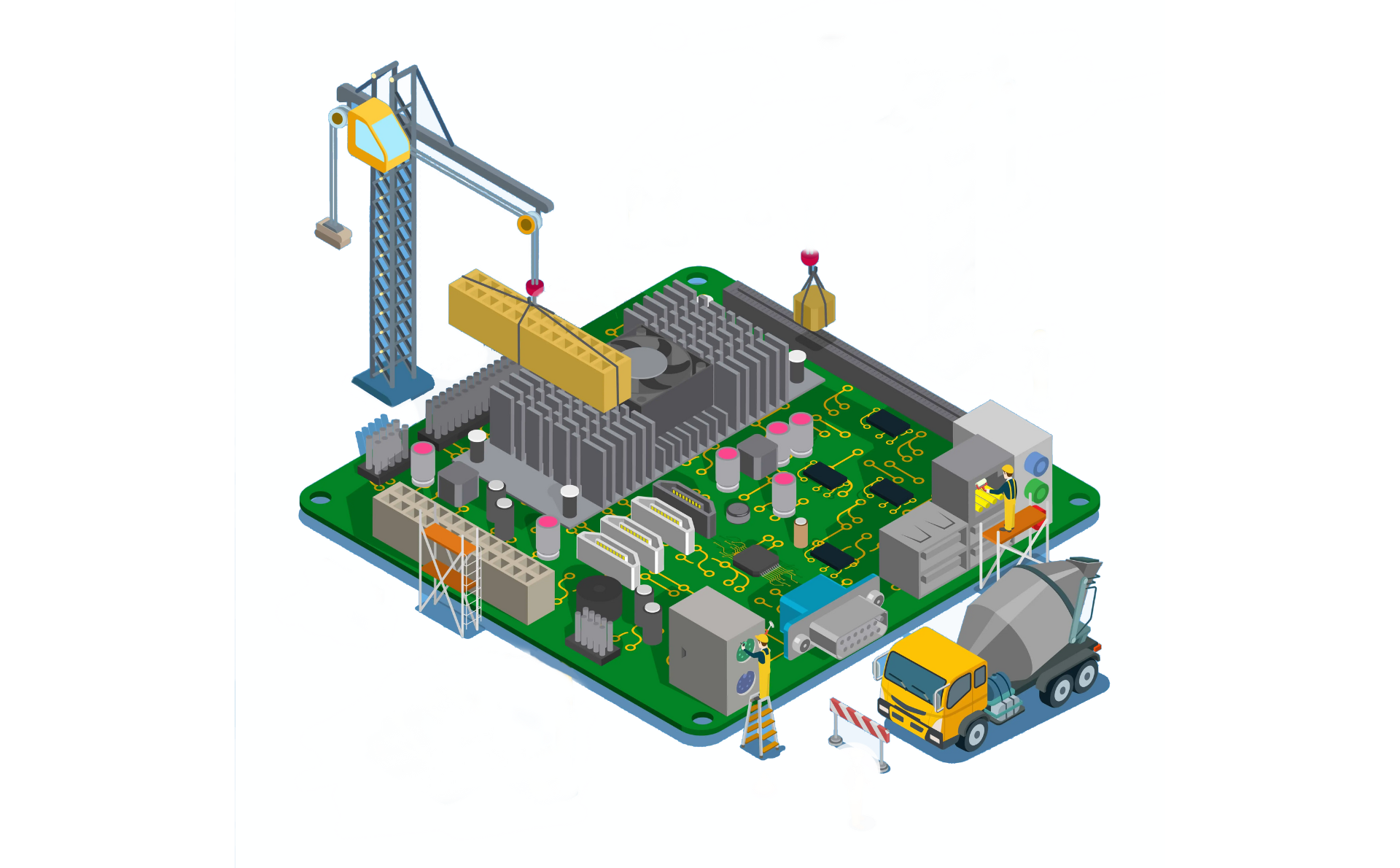
- Understanding Electronics System Design and Manufacturing
- Value Chain Analysis of ESDM Market
- Industry wise segmentation and growth opportunities
- Product/Service in ESDM Market
- Growth Drivers-Why is it right time for India?
- Industry Players
- Key Monitorable Factors
Research Analyst - Karan Sanwal (karan.sanwal@niveshaay.com)
Why does the industry look interesting to us?
India has been importing huge quantities of electronic products since decades. In fact, import of electronic products accounts for the second highest import bill. Multiple reasons like lack of infrastructure, technical know-how, cost competitiveness, etc., were responsible for low domestic manufacturing. However, there has been a paradigm shift where decades of hardship faced by electronic manufacturing companies has finally been converted to significant opportunities. Lots of factors have converged in the recent past that we are now standing at an inflection point. In modern-day India, when opportunity knocks the door, we grab it with both hands. What’s even more interesting is that if any company needs to achieve scale, they would want the entire electronics manufacturing ecosystem to develop. This would lead to simultaneous growth of multiple players, easy availability of advanced electronic products and a lower import bill. Win-win for everyone!
1. Understanding Electronics System Design and Manufacturing (ESDM)
ESDM involves a process of conceptualization, design, prototyping, manufacturing, testing, and providing after-market services for electronic systems and components. The Original Equipment Manufacturer (OEMs) around the world are increasingly outsourcing their electronic product manufacturing to the ESDM players to focus on their core business of serving the end-user.
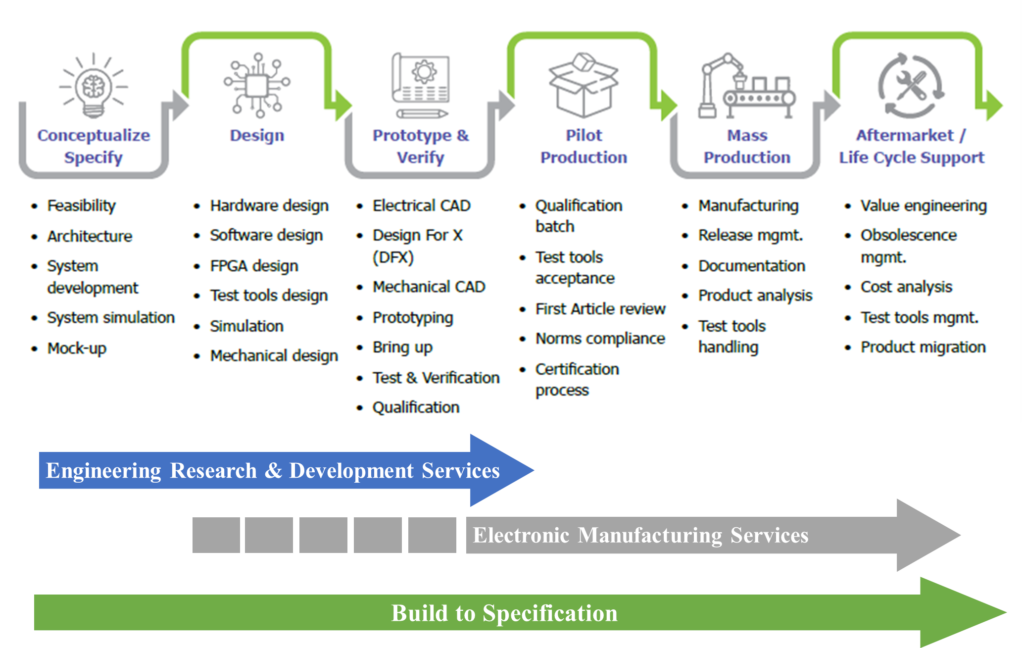
2. Value Chain analysis of ESDM market
The ESDM company, which has a presence in all parts of the value chain, enjoys high margins due to higher operating leverage, economies of scale, and preference over competitors. The value chain of an ESDM industry can be divided as follows:
1. Original Design Manufacturing (ODM) Model
- Here, the customer provides its requirements to the ESDM company. Based on the specifications provided, the technical design work is done to bring the concept to reality. The terms of the contract may include mass manufacturing and after-market services.
- This model helps the company to establish deeper and long-term business relationships. The companies in India have limited presence (20% of the total ESDM market) in the ODM model due to long gestation and large CAPEX requirements.
- Companies are gradually increasing their presence in this segment. Developed economies like the USA and Europe continue IP ownership and R&D domination.
2. Electronics Manufacturing Services (EMS) Model
- Here, the design is provided by the customer. The company sources the components from an approved list of vendors of the customers and manufactures the products in required quantities. After market services may also be provided.
- These players have large manufacturing capacities of PCBA, fabrication, plastic moulding, etc., to cater to multiple customers. They source their material in bulk and have focused on increasing efficiency to achieve economies of scale.
- This model is used in countries which have low labour cost and a good supply chain infrastructure. In India, 80% of the total ESDM market is accounted for by the EMS model.
3. After Sales Services
- Companies offering end-to-end solutions also offer after sales services like repairs and maintenance. It helps to build brand loyalty and long-term relationships with clients.
- To increase the penetration in different parts of the value chain, Indian companies have started to provide these services to their customers.
Market size of the global ESDM Industry (US $ Billion)
The global ESDM industry is expected to grow at a CAGR of 5.4% from CY21 to CY26E as opposed to 3.4% CAGR recorded from CY17 to CY21.
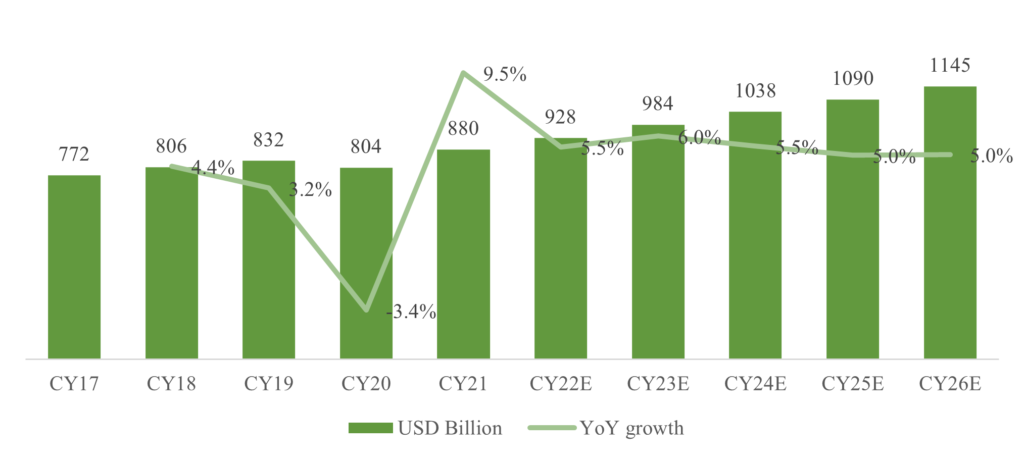
Market size of the Indian ESDM Industry (US $ Billion)
Even though the global ESDM market is expected to grow at a low single digit CAGR, India is going to outperform the market. The Indian ESDM industry is expected to grow at a CAGR of 32.5% from FY22 to FY27 as opposed to 22.2% CAGR recorded from FY17 to FY22.
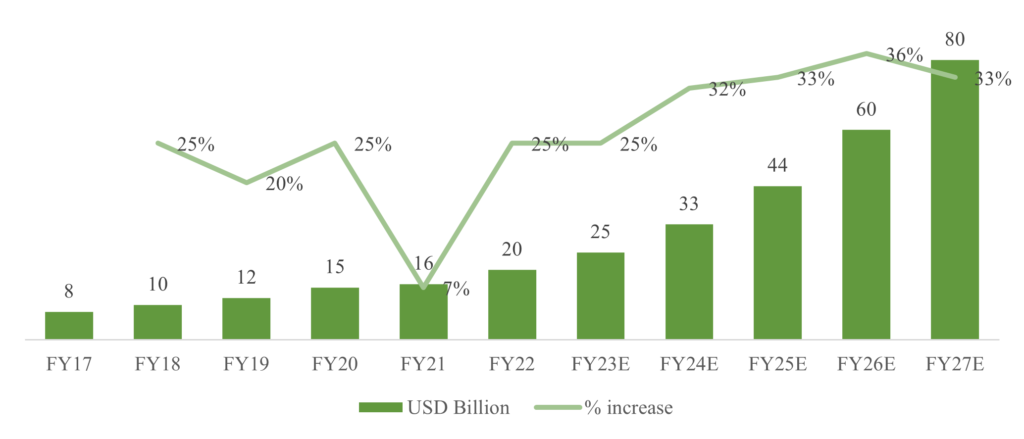
3. Industry wise segmentation and growth opportunities

Sectors based on volumes and margin
The advancement in technology and integration with artificial intelligence, machine learning, internet of things, etc., have increased the electronic content in products across various sectors. Some sectors like Aerospace & Defence, medical devices, etc., have high margins but could encounter problems related to higher gestation period and customer delays which puts pressure on working capital management. So, there are different models applicable for different sectors which are highlighted as below:
High Volume Low Margin (HVLM) model: Companies manufacturing highly automated electronics, mobile phones, or consumer electronics would be using the HVLM model. Companies try to grow volume with limited product range. Overstocking of inventory could be a problem.
Low Volume High Margins (LVHM) model: Companies manufacturing using the LVHM model would have low production volume with a wide product range. They must be able to quickly switch between different product types to accommodate customer demand. E.g., Clean Energy, Medical/ Healthcare, Aerospace & Defence, etc., have customized products with higher margins.
Low Volume Low Margins (LVLM) model: It involves companies with low production volumes and limited product mix. This could be beneficial in niche markets with high customization like Automobiles. It could also be used for prototype development
High Volume High Margin (HVHM) model: This model is prevalent in industries where products are customized and a wide variety of products are needed to meet customer demand. Effective inventory management is essential to manage a wide variety of products while avoiding stock-outs or overstocking. E.g., Internet of Things.
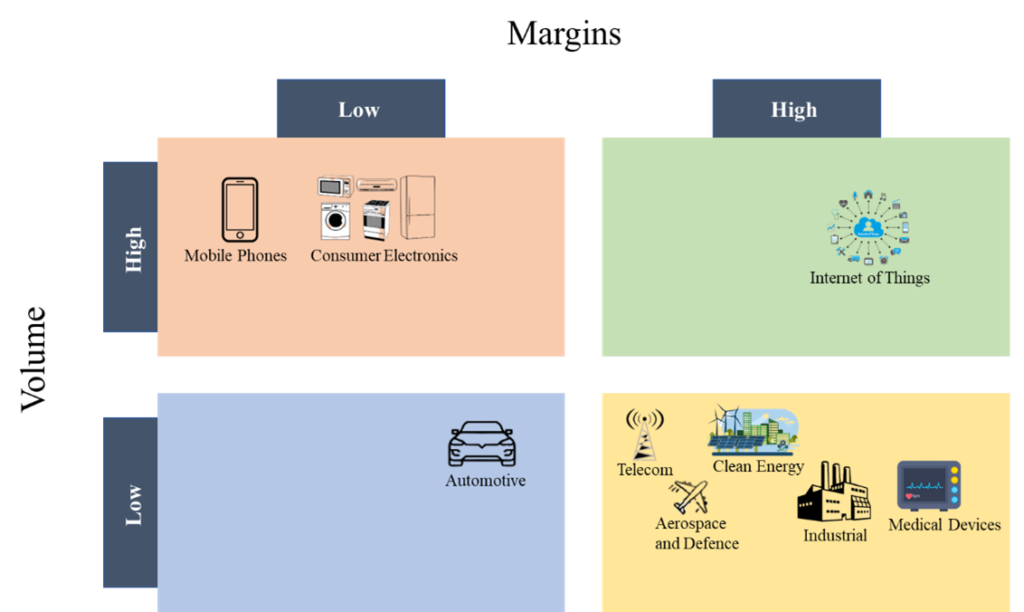
4. Products/Service in ESDM Industry

The ESDM market can be divided based on the process that starts from an idea and transitions through conceptualization of that idea along with mass scale manufacturing and after sales services.
1. Design Services and solutions
It focuses on conceptualization of an idea based on customer requirements. Market research may also be conducted to understand the requirements of the end-users. Indian companies have started providing these services to penetrate the value chain.
2. Prototyping
A proof of concept is created to test the functionality of the product. A prototype is manufactured before mass-production. Changes could be easily made while products are at prototype stage to avoid major future challenges.
3. Printed Circuit Box Assembly (PCBA)
PCB is the core product in any electronic item. It has copper lines which electrically link connectors and components to each other. The electronic components are attached with either Surface Mount Technology (SMT) or Through-Hole Mounting (THM) which is known as PCBA. Due to inadequate domestic manufacturing of PCB, 80-90% are imported and only PCB Assembly is done in India. The bare PCB contributes to around 8-10% in the overall product cost in the majority of the industry. Gradually, the ESDM players are expected to manufacture bare PCB in-house to have more control over the process (better working capital management) and better margins through backward integration.

The board on the left side is the bare PCB. Various automated and manual processes are done to solder components on it based on the product requirements. Some of the domestic manufacturers of bare PCB include Shogini Technoarts Pvt. Ltd., AT&S India Pvt. Ltd., Ascent Circuits Pvt. Ltd, Epitome Components, etc.
4. Box Build
It is a higher value-added product which constitutes a PCB in a small enclosure. An ESDM company needs to have a robust manufacturing infrastructure or an outsourcing vendor for components like Wire & Harness, Magnetics, Sheet Metals & Plastics Molding, and other electromechanical components that go in a box build. Indian companies are receiving more box builds orders which highlights the increasing vertical integration. This helps in better margins and long-term relationships with clients.
5. System Integration
The Box builds are part of a sub-system. These subsystems are combined to form a system to operate it as a single unit. This process of combining the sub-system into a single system is known as system integration. For e.g., A car contains different sub-system for braking, engine, fuel management, etc.
6. System Testing
The electronic products are tested at every stage i.e., from prototyping to dispatching to ensure that problems are not encountered by the end-user. Some sectors like aerospace, defence, railways, etc. have higher quality requirements leading to additional tests being conducted. Companies having better testing infrastructure are preferred by OEM.
7. After Sales Services
After sales services like repair, rework, and maintenance are provided so that the product is functioning efficiently. It is also done to extend the life of the component. In high value items used in railways, aerospace, defence, etc., these services are of major importance as the cost of replacements are high.
5. Growth Drivers- Why is the right time for India?
The import of electronic goods accounts for the second highest import bill after oil. According to an industry report, the Indian ESDM market, which contributed to 2.2% of the global market in CY2021, is expected to contribute around 7% in CY2026.

The global ESDM market is expected to grow at a CAGR of 5.40% over CY2021-CY2026. The major players in the global market are expected to grow at following CAGR:
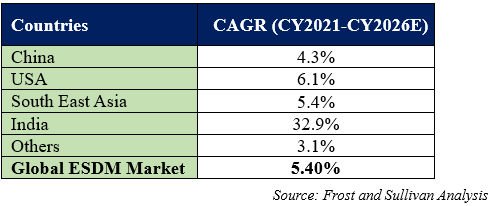
The substantial increase in India’s share is expected to come with contribution from multiple factors.
China +1
- China has been able to capture a large chunk of the market due to its manufacturing infrastructure, highly skilled labour, logistical advantages, economies of scale, etc.
- However, in the 5-year period, it is expected to grow at only a CAGR of 4.3% with a decline in its share in the global ESDM market. These trends have emerged due to rising geopolitical tensions, increased labour costs, supply chain disruptions, etc.
- Many electronic manufacturers are looking to reduce its dependence on China by establishing alternate bases in countries like India, Vietnam, Philippines, etc.
- India looks attractive due to lower labour costs, availability of skilled/semi-skilled labors, development of manufacturing ecosystem, growing domestic demand, etc.

Government push
- The Government of India has launched multiple policies and initiated campaigns like AatmaNirbhar Bharat to develop India as an electronics manufacturing hub.
- The National Policy on Electronics was launched in 2019 to develop major components like chipsets, integrated circuits, etc. and establish the ESDM value chain to compete globally.
- The Scheme for Promotion of Manufacturing of Electronic Components and Semiconductors (SPECS) was launched to solidify the electronic components and semiconductor’s manufacturing ecosystem. It will lead to expected new investment of Rs. 20,000 cr for electronic components and sub-assemblies.
- The Modified Electronics Manufacturing Clusters Scheme (EMC 2.0) provides financial assistance for establishing EMC projects and Common Facility Centers to strengthen the supply chain, lower logistic cost, and decrease time-to-market.
- The Design Linked Incentive Scheme (DLI) will provide financial incentives and design infrastructure support for development and deployment of semiconductor design for Integrated Circuits, Chipsets, Systems & IP Cores over a 5-year period.
- Following Product Linked Incentive (PLI) Scheme was launched to encourage domestic manufacturing and attract investments for respective products.

Increasing electric components
- One of the primary reasons behind the growth of the global electronics industry is the increasing electronic components in products across various industries.
- Advancements in technology have allowed for miniaturization, improved performance, and energy efficiency, leading to usage of more electronic components. For e.g., Electric vehicles generally require 3x more semiconductors than internal combustion engine cars, due to the complex electronic systems needed for battery management, power electronics, electric motor control, etc.
- Electronic products have wide usage from as simple as consumer products to complicated defence and aerospace products.
According to the industry report, all sectors in the Indian ESDM market are expected to outperform the sectoral growth in the global ESDM industry by a significant margin.

6. Industry Players
For any company, it is difficult to cater to all segments or sectors as the machinery, volume, and complexity of the products are different. So, companies develop a niche to focus on particular segments/industries. They make efforts to establish long term relationships with clients through timely execution of orders. The ultimate goal is to increase the scale of business, which helps in improving margins, revenue contribution, sourcing ability and negotiations.
Companies in the industry can be compared based on the sectors they serve, order book position, working capital management, timely execution, and profitability.
The below table highlights the industry players and the respective sector they serve:

7. Key Monitorable Factors
The ESDM industry has significant demand for multiple players to co-exist. The order book position of various companies and market forecasts highlights the upward trajectory. Though the industry is poised for significant growth, following parameters should be monitored:
Import of Raw material and equipment
- The ESDM companies in India are importing the majority of its raw material. Around 60-70% of the components are imported and others are sourced internally. This increases the lead time of components and dependence on the supplier.
- The supplier from whom the materials are domestically sourced are actually importing. This makes the total import of most of the companies around 80-85%.
- The equipment used during the electronic manufacturing process is imported as well. This increases the import dependency of such players.
- India is expected to set up domestic manufacturing of these materials. But these developments would take some time due to high technological know-how and CAPEX requirements.
- If such facilities are set-up, the ESDM companies would have more control over the supply chain and possible margin expansion.
Inventory management
- Many companies have faced problems with elevated inventory which has created challenges for managing working capital.
- The clients have asked companies to maintain high inventory levels so that the products can be supplied without any interruptions. Even though the customer would not cancel orders due to high switching cost, this has led to high inventory levels.
- An electronic product is manufactured through multiple components. Absence of few components could halt the production. This imbalance of inventory leads to inventory pressure.
- One of the possible solutions would be taking customer advances to manage the pressure of inventory.
Execution of order book
- The companies in the industry have experienced a significant increase in order books in recent times.
- Supply chain disruptions caused by the pandemic and geo-political tension had created a lot of problems. Even though the supply chain issues have decreased they haven’t been completely eliminated.
- The execution of these robust order books would be an important tracking element going forward.
Disclaimer:
Investment in securities market are subject to market risks. Read all the related documents carefully before investing.
Registration granted by SEBI, membership of BASL and certification from NISM in no way guarantee performance of the intermediary or provide any assurance of returns to investors.
The securities quoted are for illustration only and are not recommendatory.
Disclaimers and Disclosures
SEBI Registration No. :INH000017338, IN/AIF3/24-25/1571, IN/AIF2/24-25/1607 | BASL Membership ID: 6276
Investment in Securities Market are subject to market risks. Read all related documents carefully before investing. The securities quoted are for illustration only and are not recommendatory. Registration granted by SEBI, membership of a SEBI recognized supervisory body (if any) and certification from NISM in no way guarantee performance of the intermediary or provide any assurance of returns to investors.


 Follow
Follow